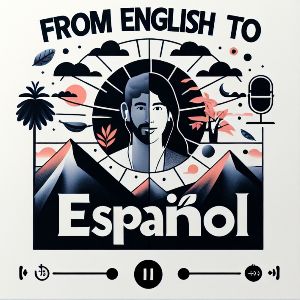The Conditional Perfect Tense in Spanish
May 02, 2025Categories: , Lesson


From English to Español: Bridging the Grammar Gap with Alberto Rodriquez
Welcome to "From English to Español: Bridging the Grammar Gap", the podcast created specifically for English speakers ready to take their Spanish skills to the next level. Each episode dives into the core differences and surprising similarities between English and Spanish grammar, unraveling the complexities of the language in a way that’s clear, practical, and easy to follow. We'll break down essential concepts like verb conjugations, gendered nouns, and the tricky subjunctive mood, offering insights and tips that simplify these new rules and help you avoid common pitfalls. By comparing Spanish structures directly with English, you’ll quickly understand how to adapt what you already know into accurate, natural Spanish. Whether you’re a beginner or looking to brush up on advanced topics, this podcast is your comprehensive guide for bridging the gap between English and Spanish grammar, so you can speak and write with confidence. Join us daily for a new rule or concept, complete with practical examples, exercises, and memorable explanations that make learning Spanish engaging and enjoyable. Perfect for self-learners, students, and anyone serious about mastering Spanish grammar, "From English to Español" is your go-to resource for building fluency from the ground up.
The Conditional Perfect Tense in Spanish: Formation, Usage, and Exceptions
As you progress in your Spanish studies, understanding more complex verb tenses becomes essential. One such tense that often appears in both written and spoken Spanish is the Conditional Perfect. This tense allows speakers to express actions that would have occurred under certain conditions. Today, we will explore how to form the Conditional Perfect tense, when to use it, and some exceptions that will help you avoid common pitfalls.
Formation of the Conditional Perfect
The Conditional Perfect tense is constructed with two parts:
- The conditional form of the auxiliary verb haber: habría, habrías, habría, habríamos, habríais, habrían.
- The past participle of the main verb.
Recall that the past participle for regular verbs is formed by removing the infinitive ending and adding:
- -ado for -ar verbs (e.g., hablar → hablado)
- -ido for -er and -ir verbs (e.g., comer → comido, vivir → vivido)
Let's look at an example verb, hablar (to speak):
- Yo habría hablado — I would have spoken
- Tú habrías hablado — You would have spoken
- Él/Ella habría hablado — He/She would have spoken
Similarly, for comer (to eat):
- Nosotros habríamos comido — We would have eaten
- Ellos habrían comido — They would have eaten
Usage of the Conditional Perfect
The Conditional Perfect is primarily used to describe hypothetical actions or events that did not happen but would have happened under different circumstances. It often appears in conditional statements expressing regrets, speculations about the past, or assumptions.
Here are some typical situations where you would use the Conditional Perfect:
- To express what would have happened in the past if conditions had been different:
Si hubieras estudiado más, habrías pasado el examen. (If you had studied more, you would have passed the exam.)
- To make a polite or soft speculation about the past:
Habrá llegado tarde; habría perdido el tren. (He/she must have arrived late; he/she might have missed the train.)
- Expressing regret or criticism:
Habría sido bueno que me avisaras antes. (It would have been good if you had informed me earlier.)
Important Exceptions and Irregularities
While forming the Conditional Perfect is straightforward, here are some exceptions and important notes to keep in mind:
- Irregular Past Participles: Some verbs have irregular past participles that must be memorized. For example:
- abrir → abierto
- escribir → escrito
- hacer → hecho
- poner → puesto
- ver → visto
- volver → vuelto
It's important to use these correct forms when constructing the tense. For example:
Ella habría hecho la tarea si hubiera tenido tiempo. (She would have done the homework if she had had time.)
- Differences Between the Conditional Perfect and the Pluperfect Subjunctive: Do not confuse the Conditional Perfect (habría + past participle) with the Pluperfect Subjunctive (hubiera + past participle). The former expresses hypothetical past events with a level of certainty, while the latter is used in contrary-to-fact conditions and subjunctive contexts.
- Negative Forms: When making negative statements, place no before habría. For example:
No habría comprado el coche si fuera más caro. (I wouldn't have bought the car if it were more expensive.)
- Use with Modal Verbs: The Conditional Perfect can be combined with modal verbs like deber to express probability or obligation in the past:
Él debería haber llegado a tiempo. (He should have arrived on time.)
Summary
Mastering the Conditional Perfect tense will add nuance to your Spanish, enabling you to talk about what would have happened under different circumstances. Remember the structure:
Conditional form of haber + past participle
Practice using regular and irregular verbs, and pay close attention to the context in which this tense is applied. By doing so, you'll build confidence and accuracy in your conversations and writing.
For further detailed explanations and additional practice exercises, Learn more at ScienceBasedLearning.com.
Get Your Copy of comprehensive Spanish grammar guides and enhance your learning with proven methods and clear examples at ScienceBasedLearning.com.
Understanding the Spanish Conditional Perfect Tense: Formation, Uses, and Exceptions Learn how to form and use the Spanish Conditional Perfect tense with examples, tips, and exceptions to enhance your language skills effectively. Spanish grammar, Conditional Perfect, Spanish verbs, Past participle, Spanish learning, Spanish tenses Spanish Grammar Lessons
 |
Master A New Language With Science-Based Methods
|
Post Tags: